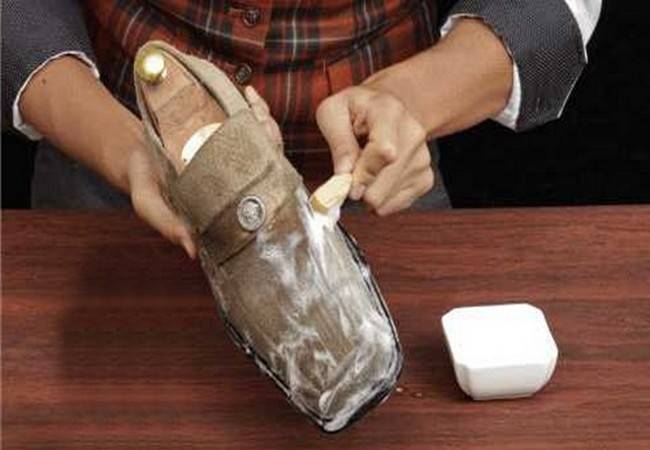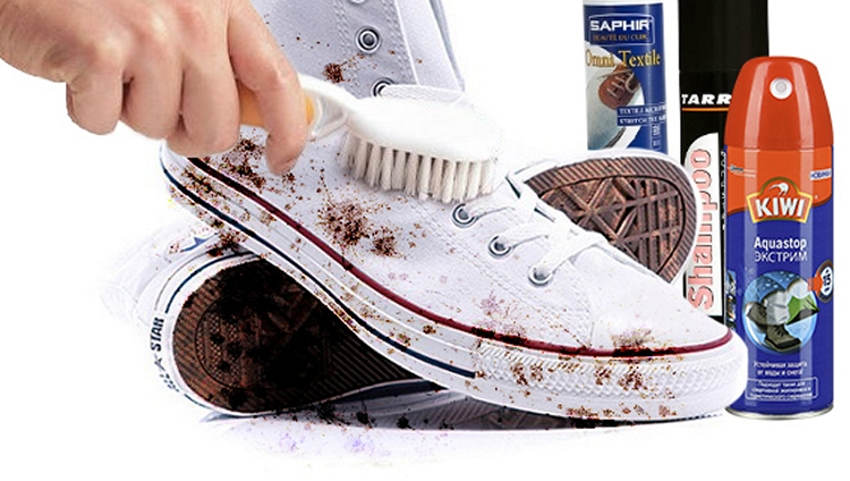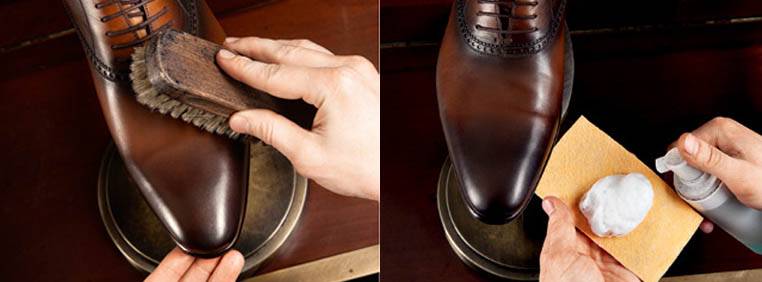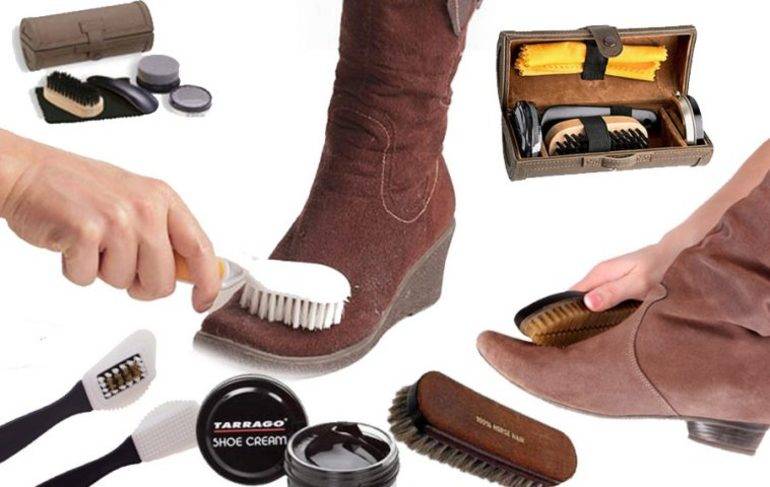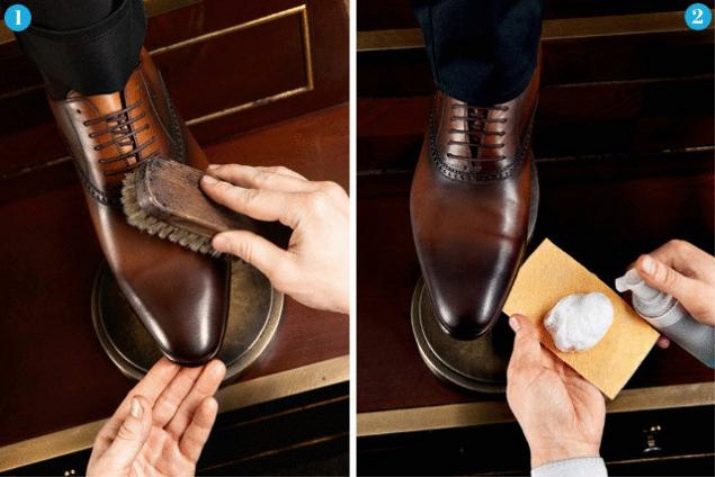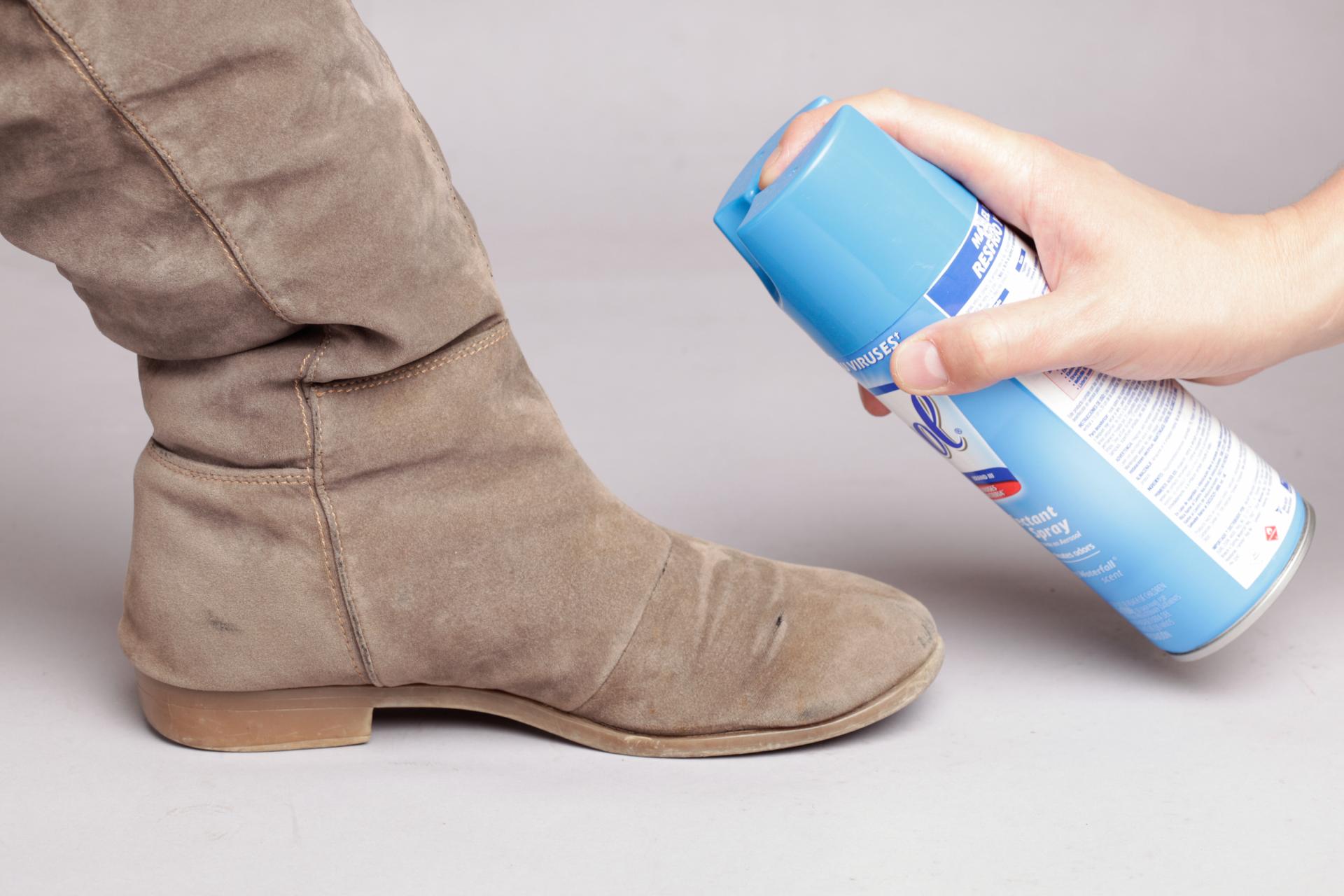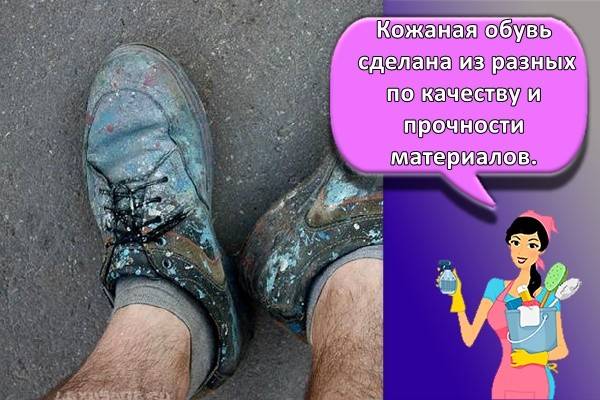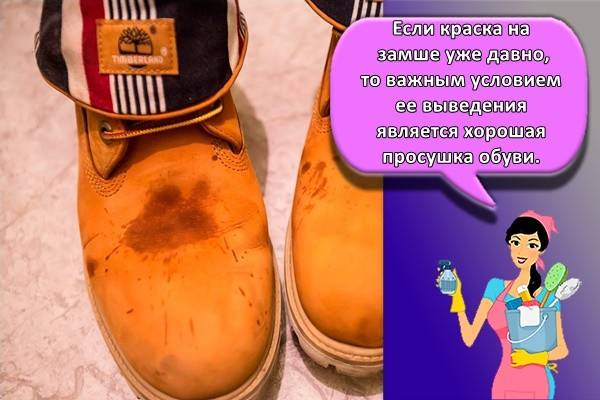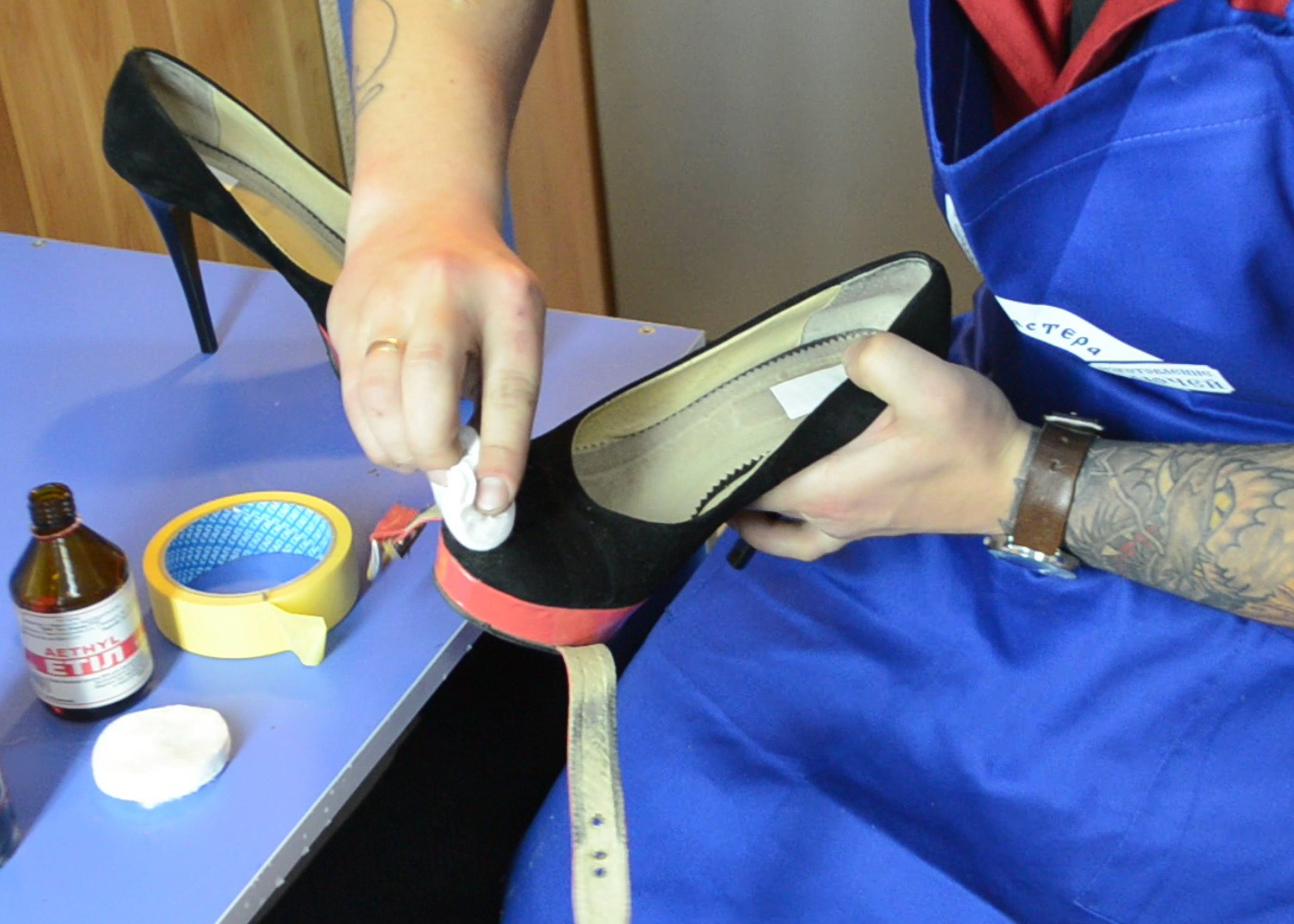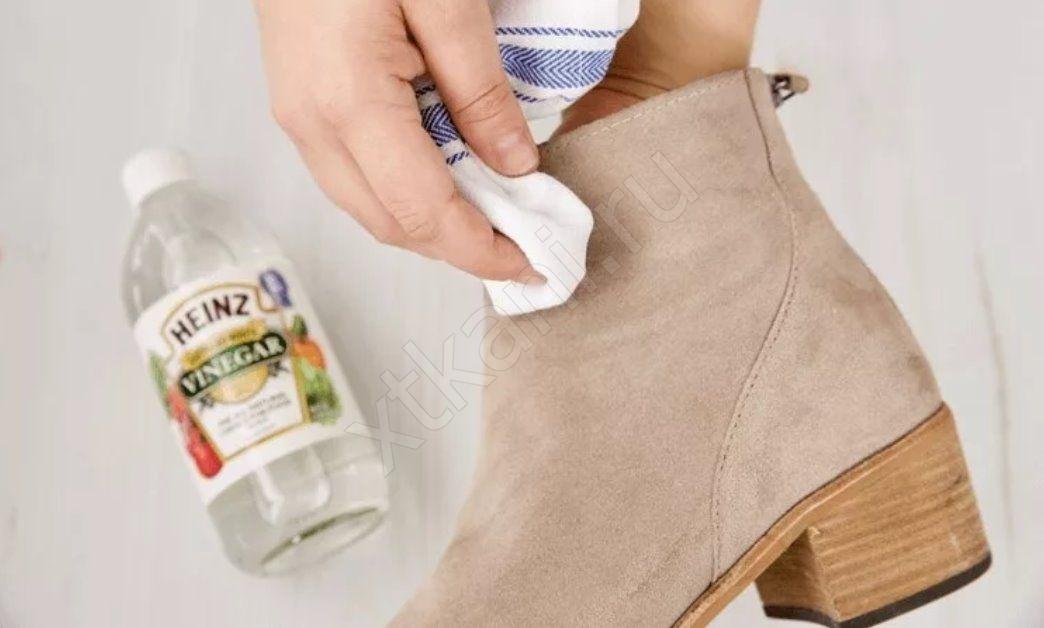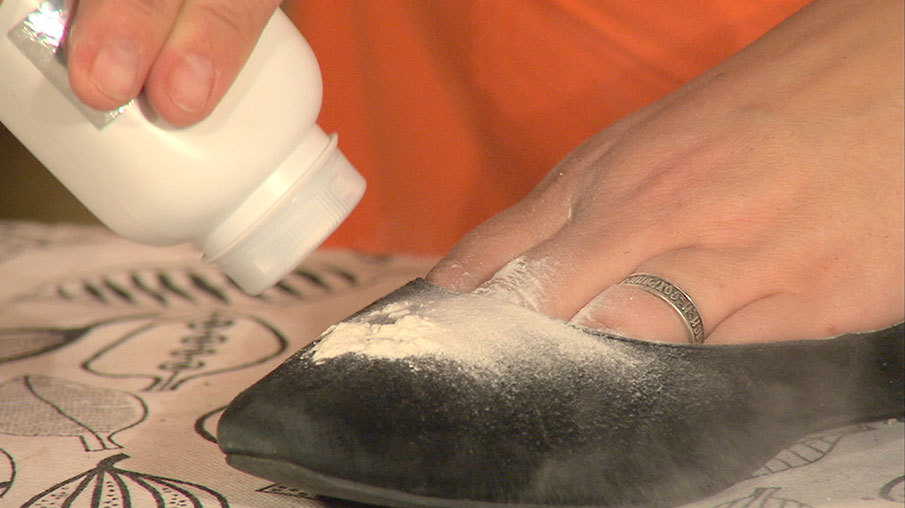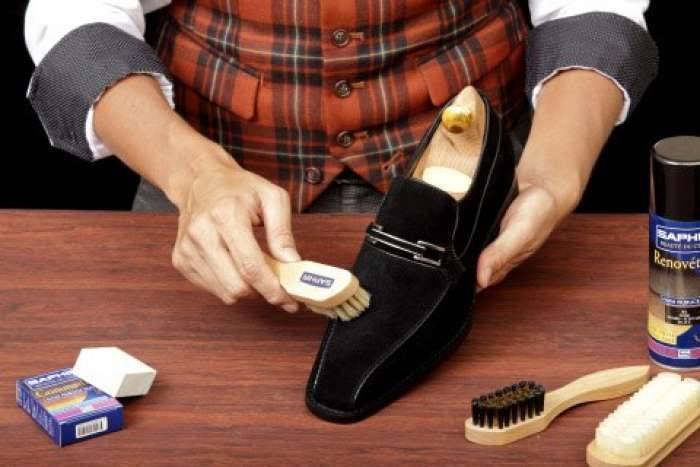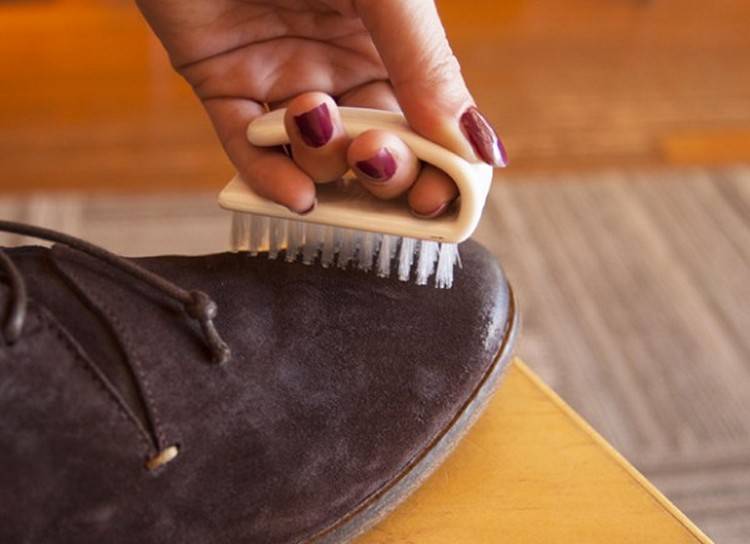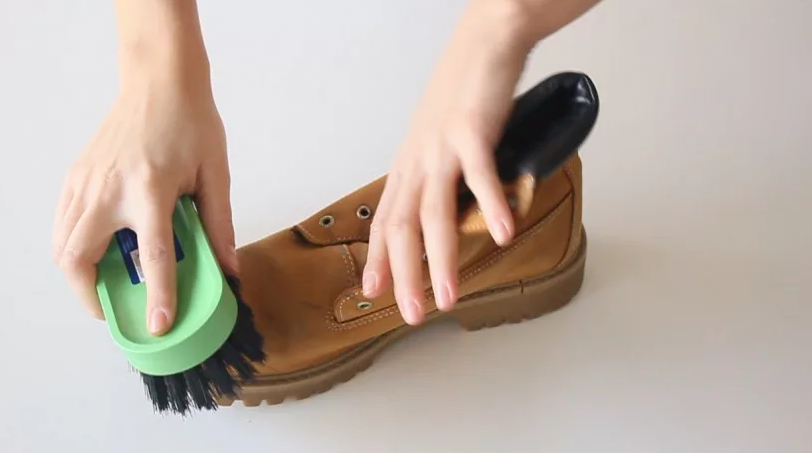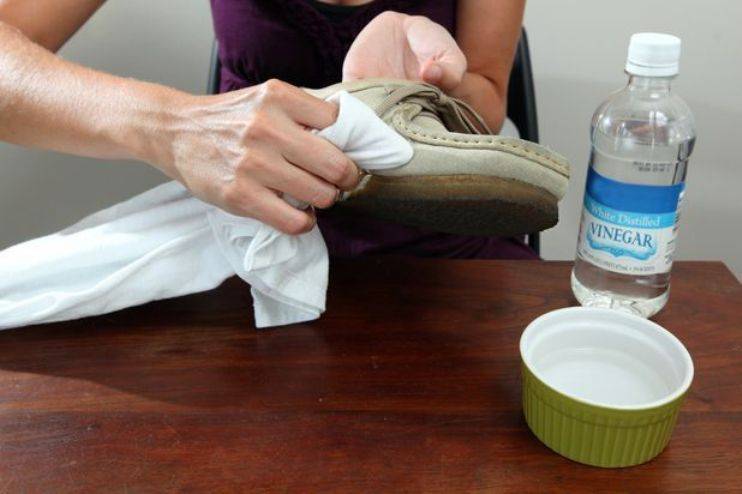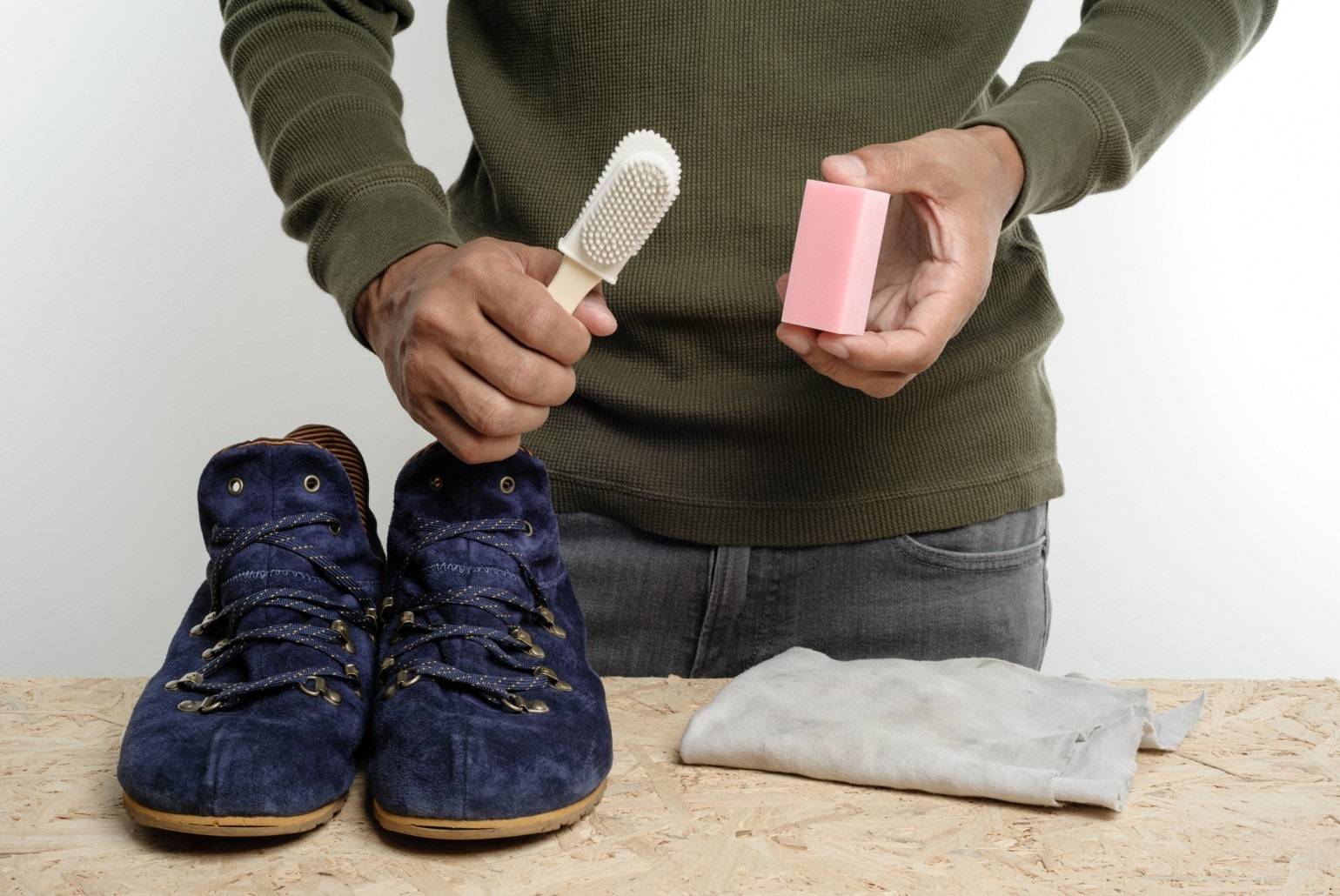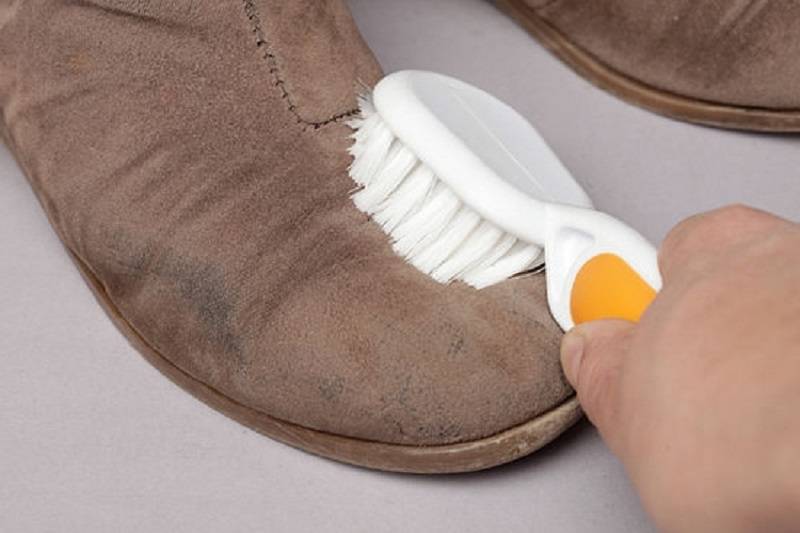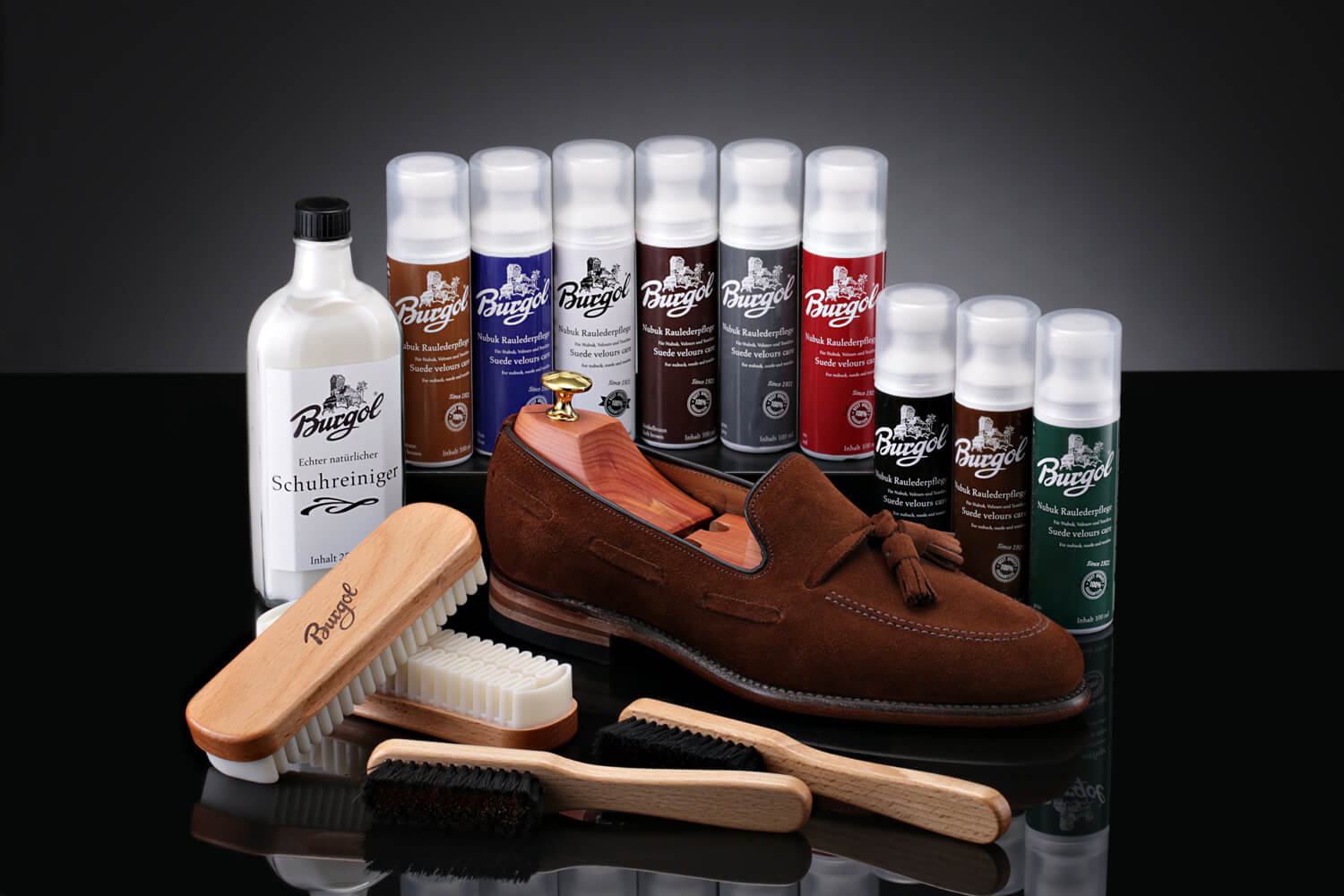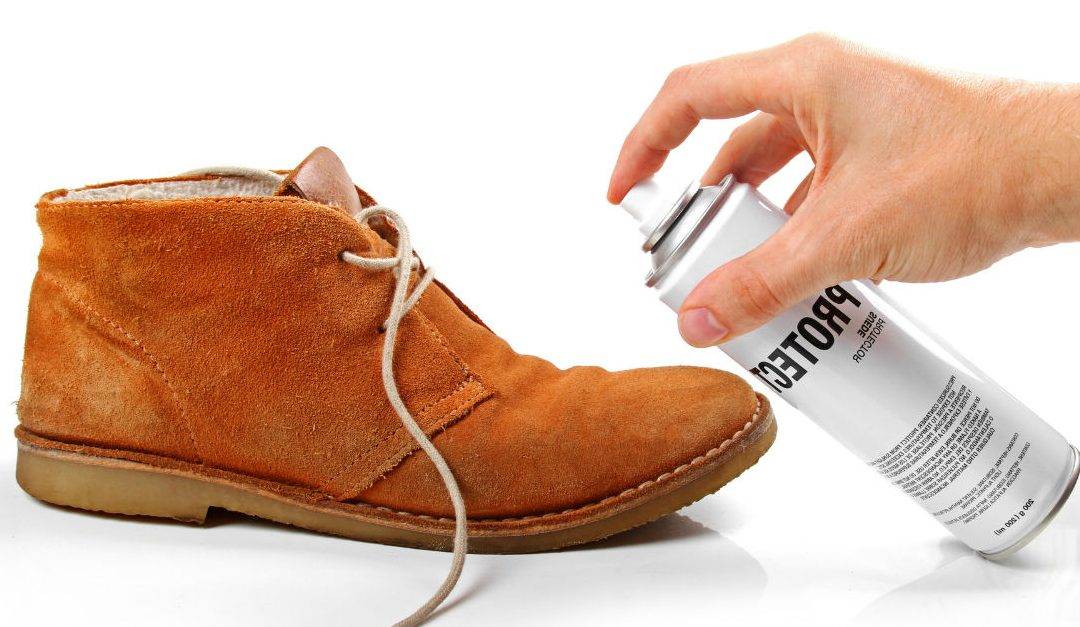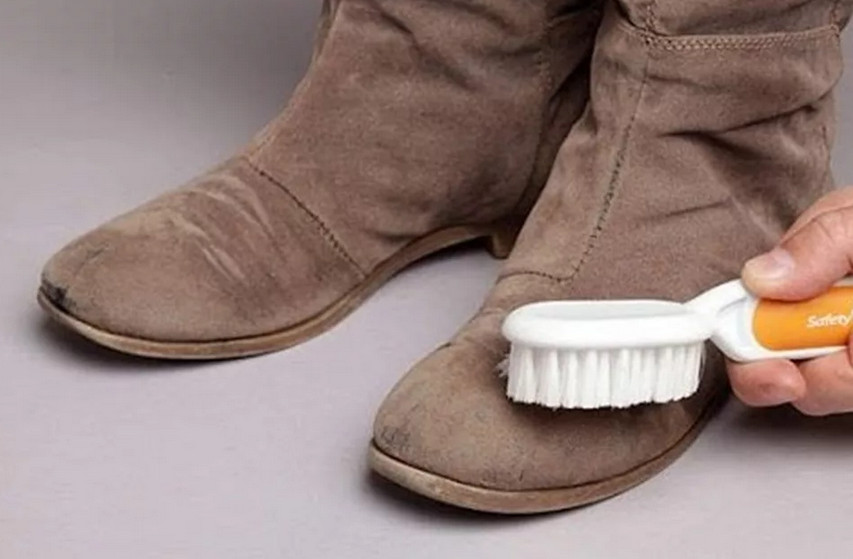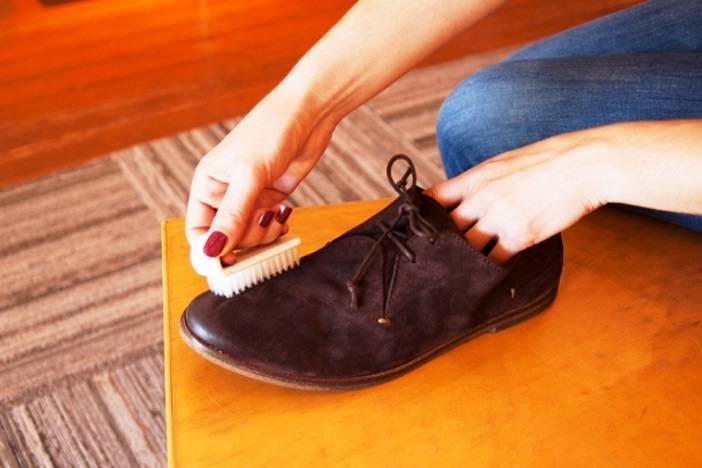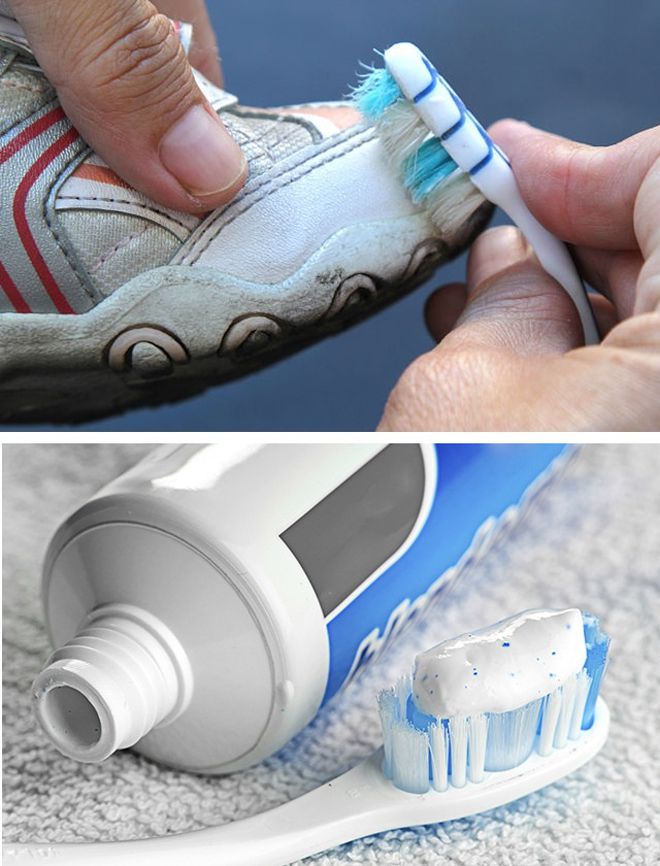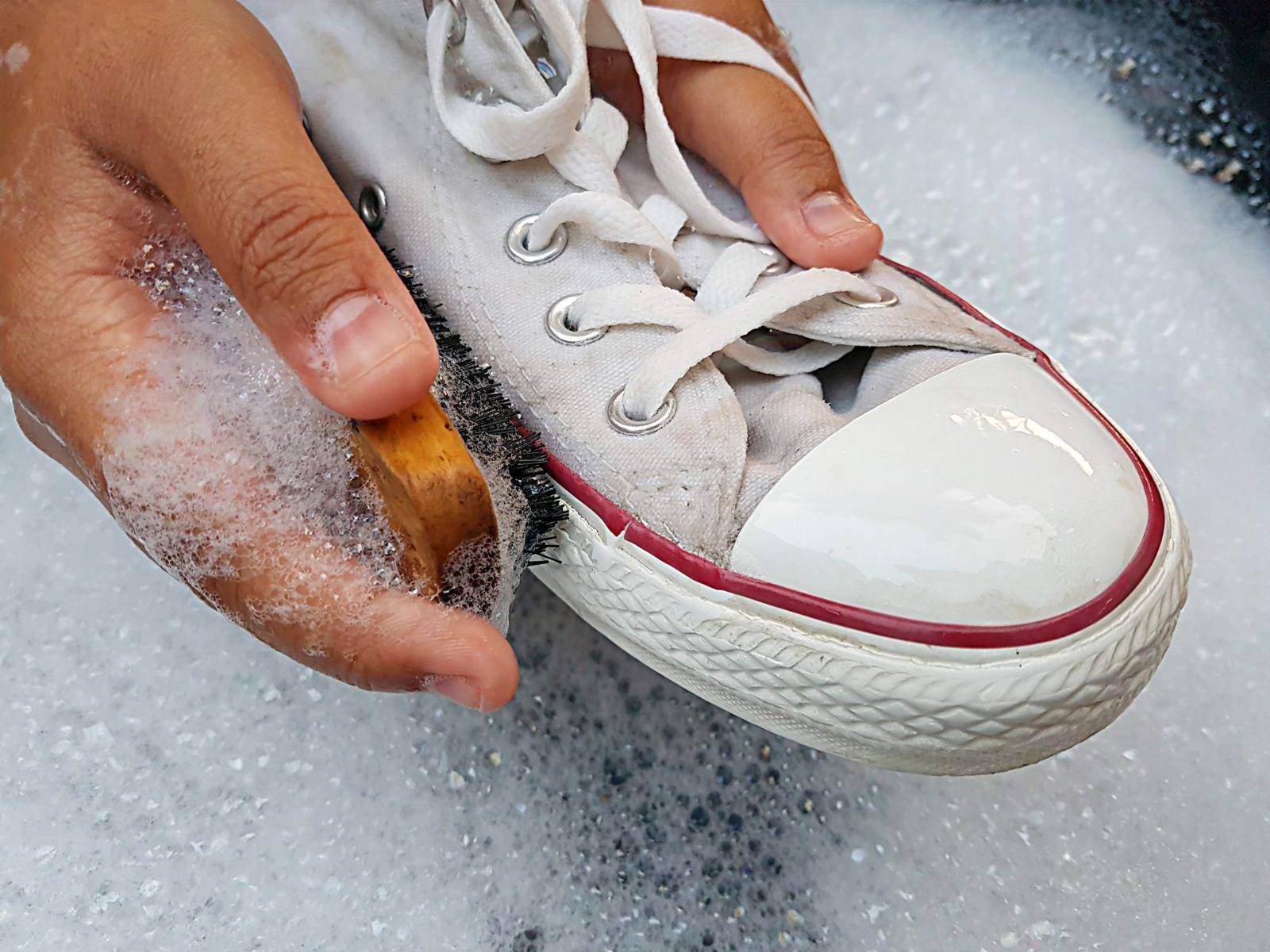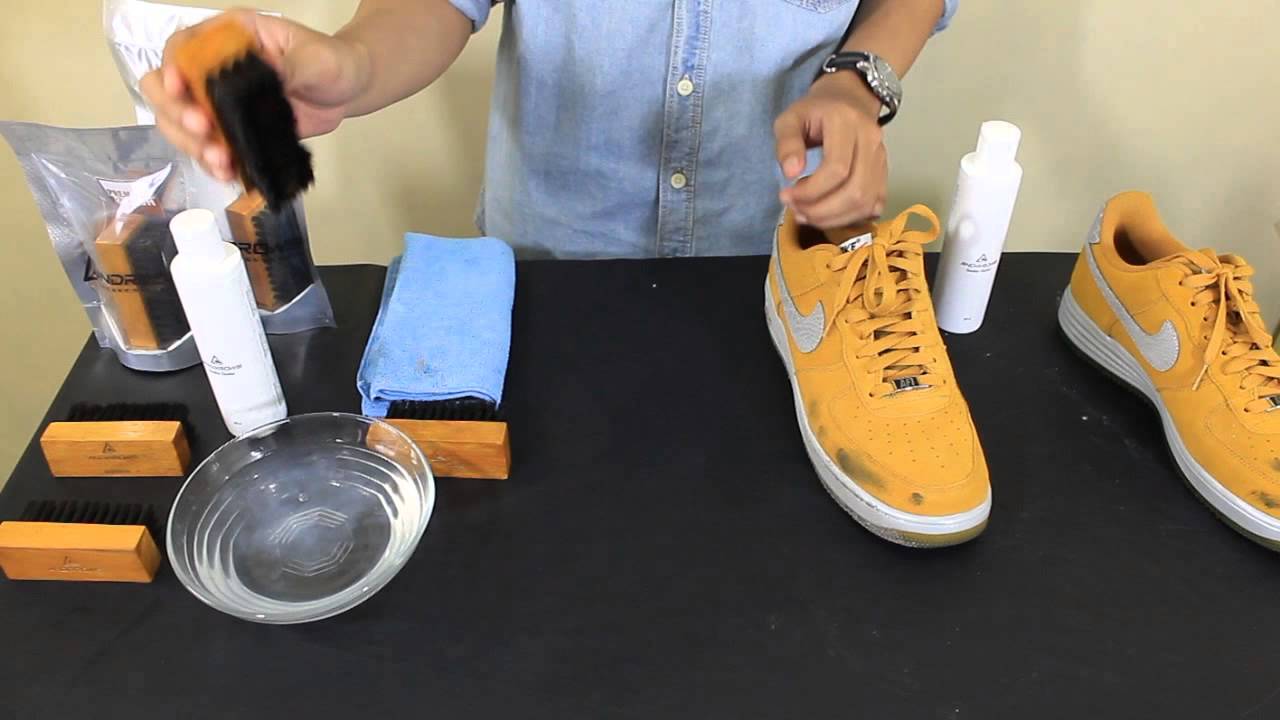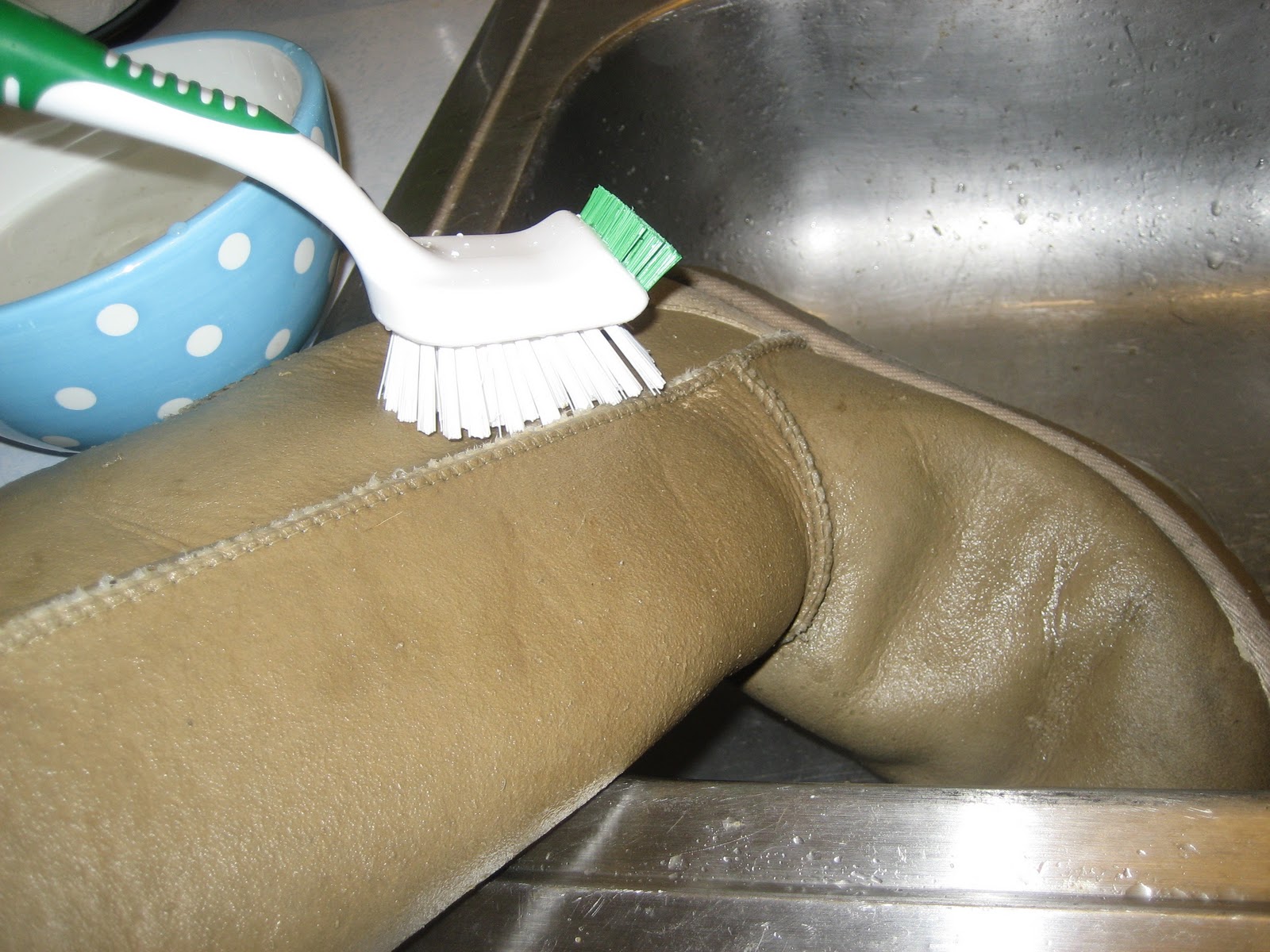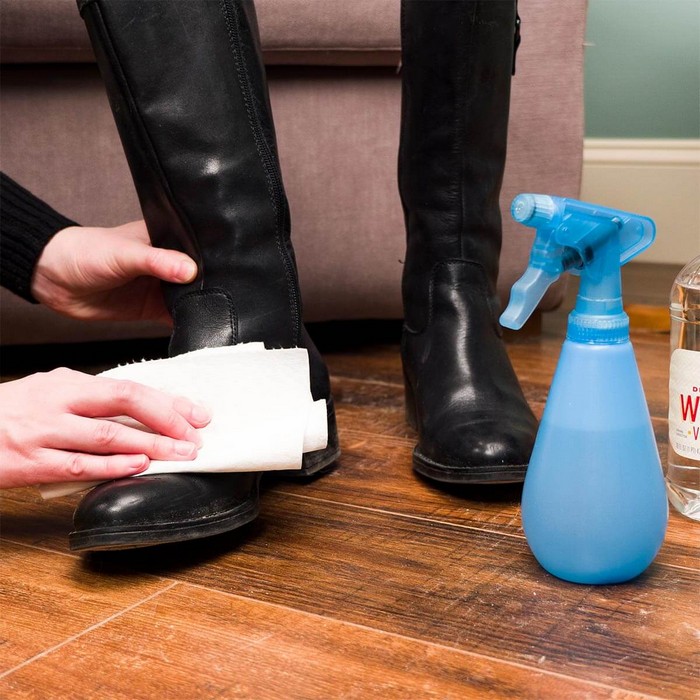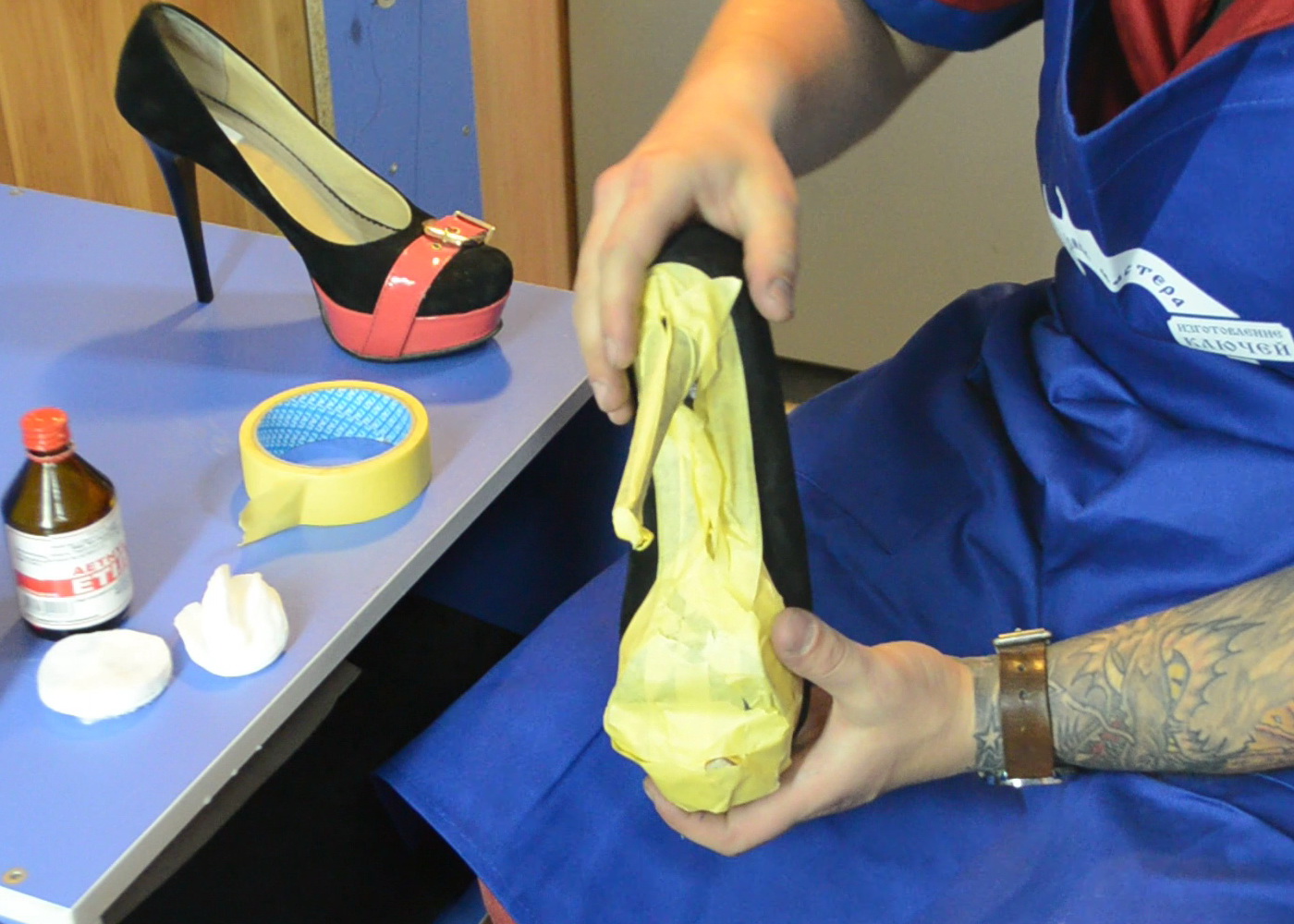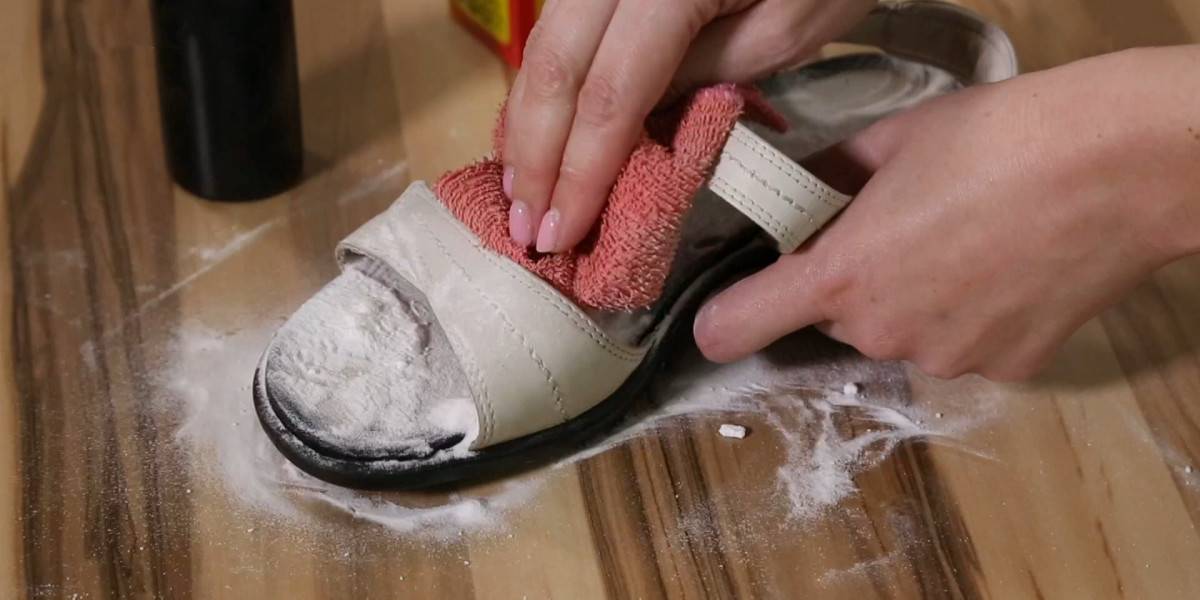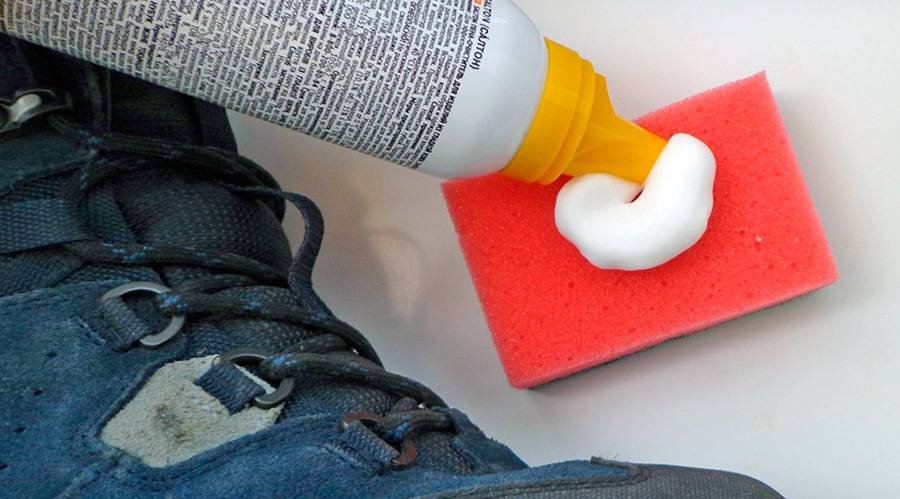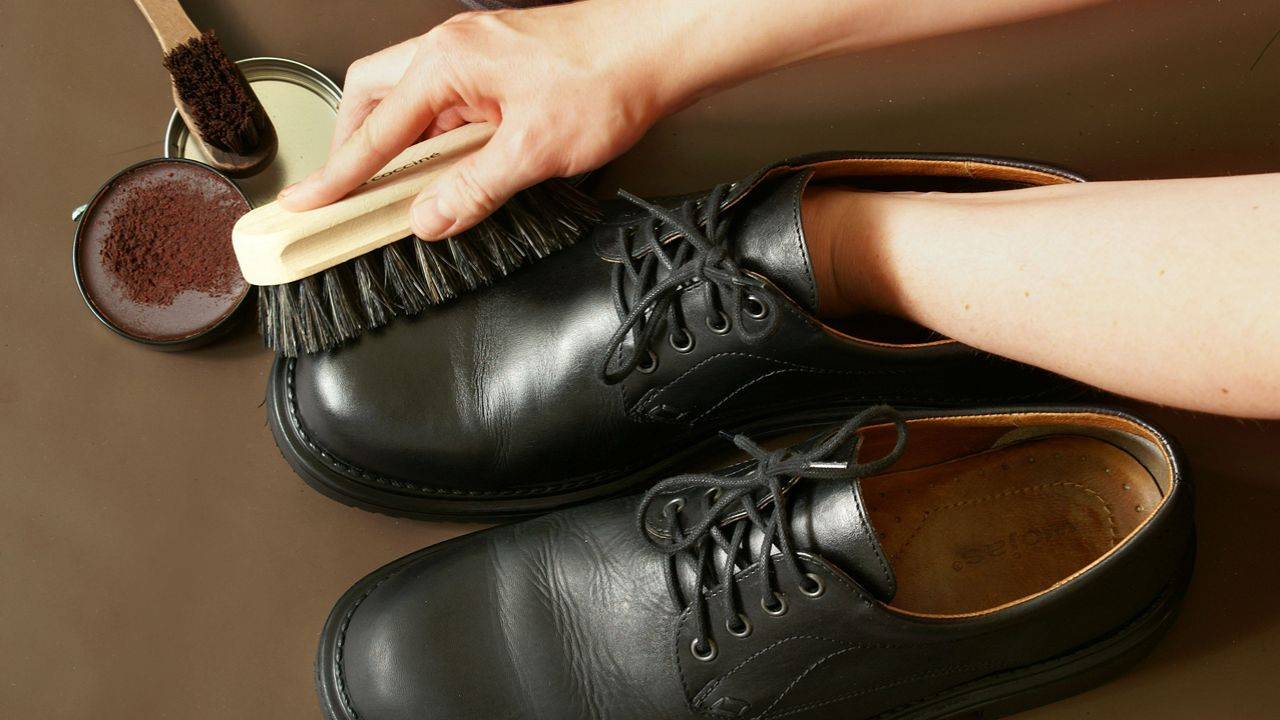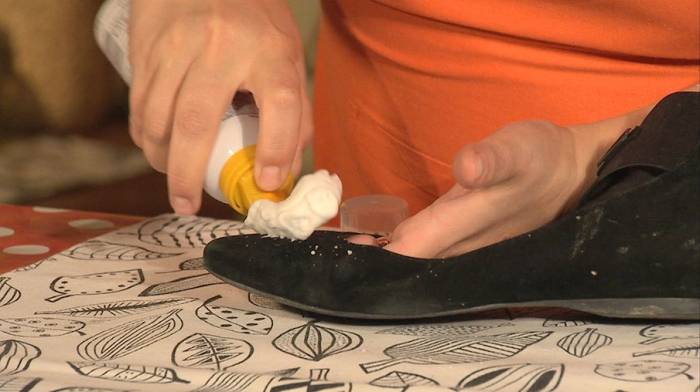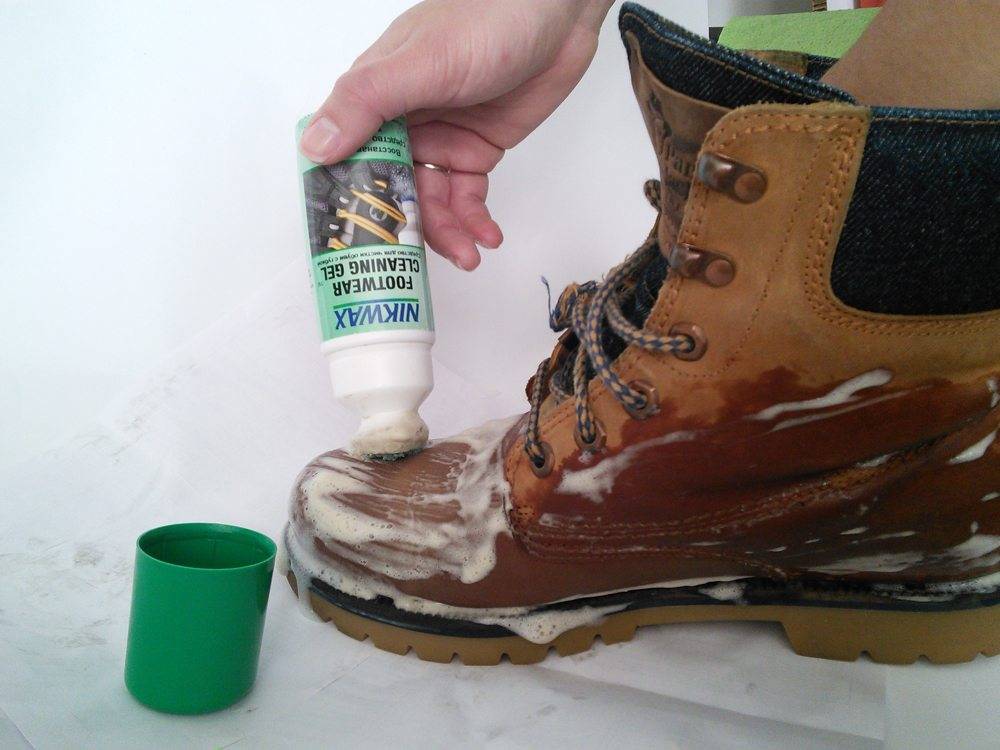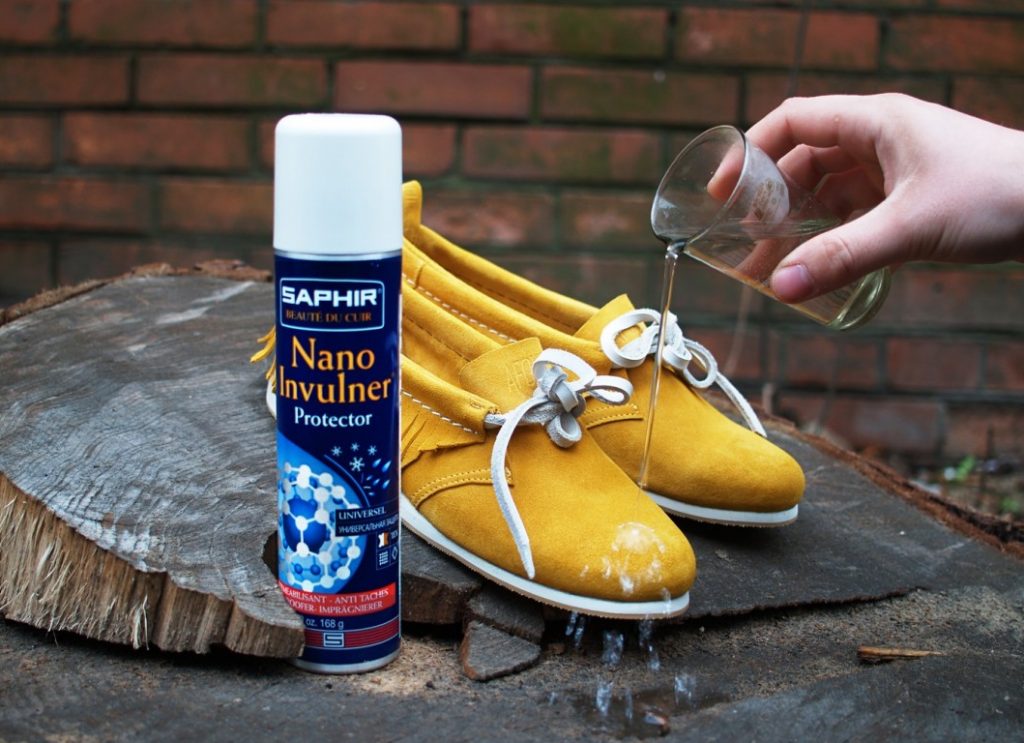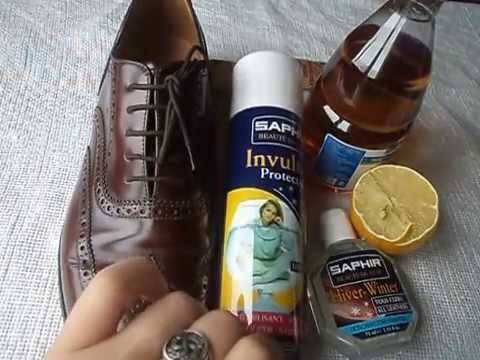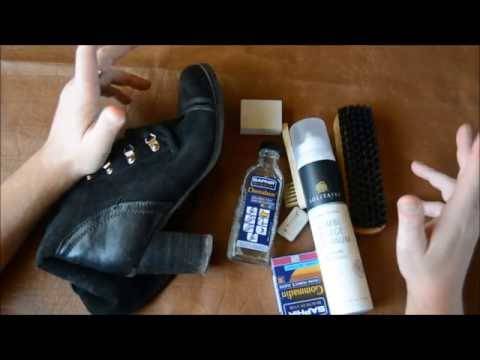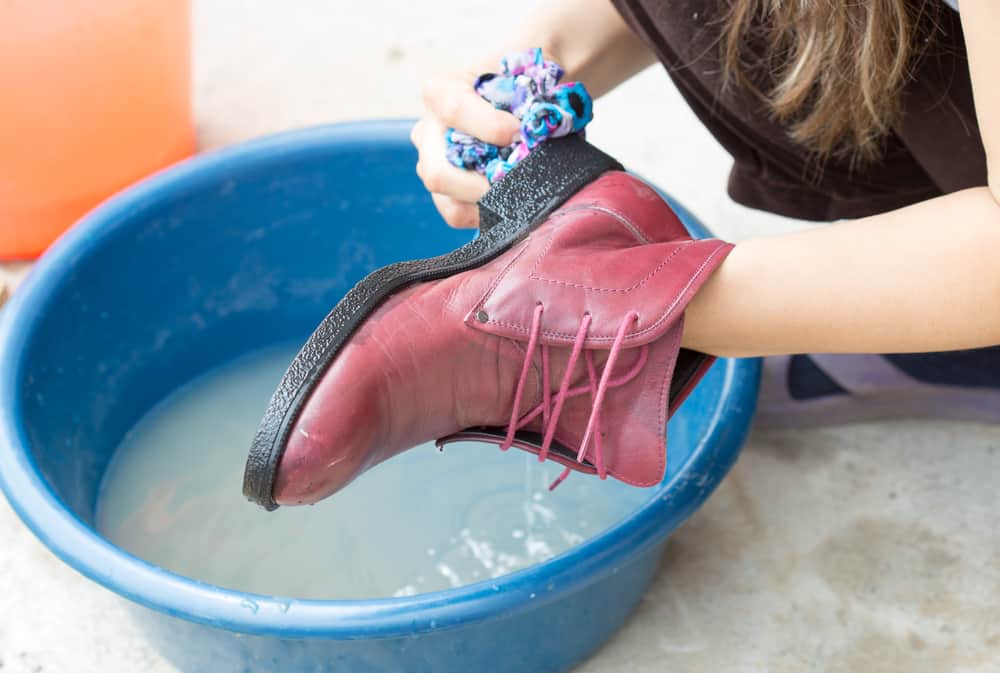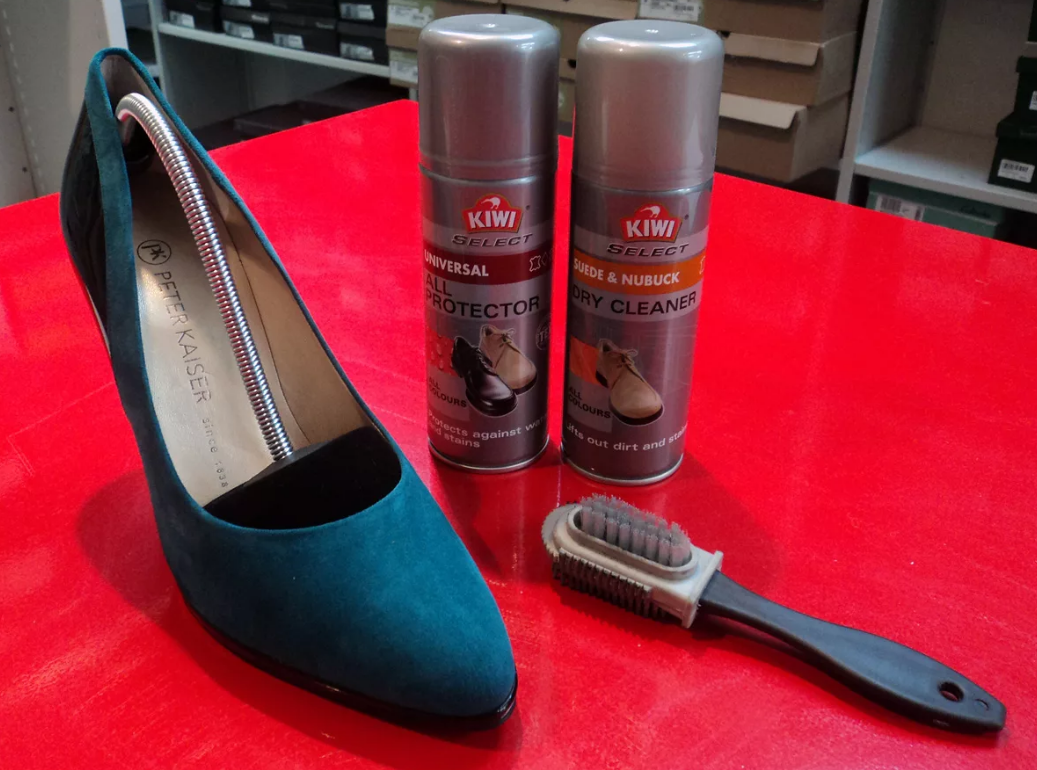How to clean clothes
Dampen a cotton swab in fir oil (available at the pharmacy) and apply to the inside of the stained cloth. Use the second piece of cotton to wipe the greasy stain of the oil product. The bottom swab will absorb all the dirt and the stain will gradually disappear.
Attention! To avoid white burnt spots, never use thinner or acetone!
Also, in the stores of household goods you can find special products that help get rid of oil stains. In the instructions for these tools, you can read for which materials it is best suited.
When using industrial chemicals, it is important:
- Read the composition carefully (avoid products containing formaldehyde, nitrobenzene, A-surfactants and other harmful substances);
- Be sure to use personal protective equipment (bandage, gloves, and sometimes special clothing);
- Avoid direct sunlight and open flames;
- Observe the instructions and dosages, do not exceed the recommended exposure time of the drug;
- Keep track of the expiration date of household chemicals (immediately get rid of expired products);
- Rinse the surfaces well after cleaning them with household chemicals, and also immediately ventilate the premises.
How to clean and bleach the sole of sneakers and other shoes: folk recipes
The use of folk remedies is an ideal way to self-clean shoes from dirt and yellowness. To do this, use:
- toothpaste (powder);
- hydrogen peroxide;
- citric acid;
- a mixture of soda and vinegar with water;
- nail polish remover;
- an eraser or melamine sponge.
Toothpaste (powder) - a quick way to clean the rubber sole from dirt
For this method, it is better to choose a composition with a whitening effect without color additives.
- Use a hard-bristled brush and toothpaste to clean the surface.
- Wait 20 minutes.
- Rinse your shoes thoroughly in warm running water.
Toothpaste can be used to clean white soles
Hydrogen peroxide
Treat problem areas with hydrogen peroxide (3%). This solution will restore the sole to its perfect white color and gently remove any stains.
Hydrogen peroxide is an excellent remedy for whitening the soles of sneakers, sneakers
Citric acid or lemon for yellow spots
Citric acid or lemon pulp will help remove yellowish tinge and gray deposits.
- Rub the problem areas thoroughly with powder or pulp.
- Leave on for fifteen minutes.
- Wash well with clean water.
Lemon can help remove dirt on white sneaker soles
Baking soda, vinegar, and water are the most popular ways to cleanse anything.
There are three ways you can use baking soda and vinegar to remove dirt from rubber.
- Wipe problem areas with a solution of vinegar and water in a ratio of 1: 3.
- Prepare a gruel from vinegar and soda in a ratio of 1.5: 1, apply it with a sponge to the sole. When the mixture dries up, wash it off with warm water.
- Thoroughly rub the dirt with soda using a damp brush, removing dirt from all the grooves on the rubber, and then rinse the shoes with water.
Blend of baking soda and vinegar is a great cleanser similar to oxygen bleach
Nail polish remover or acetone
When using these products, excellent results are achieved, but they have a pungent odor, which complicates the work. In addition, there is a risk of damage to the integrity of the sole. Therefore, before cleaning, it is necessary to carry out an express test: apply the liquid to an inconspicuous small area. If no damage appears, you can use the product.
- Moisten a cotton pad with acetone.
- Wipe the surface gently.
- Wash shoes thoroughly with clean water.
Liquid for nail polish remover with acetone - good for removing yellowish stains from white shoe soles
Regular stationery eraser or melamine sponge
The eraser should be white, which does not leave stripes on the surface when erased.
- To process the grooved sole with an eraser, without missing a single depression, well cleaning yellowness, dirt and black stripes.
- When finished, wipe the product with a clean, soft cloth.
You do not need to use water with this cleaning method. For one pair of shoes, you need to take a large enough eraser, and if the surface of the sole is uneven, then you will need small pieces to clean the thinnest grooves. The hard side of the eraser can damage the structure of the material and leave unwanted streaks. For this reason, only the soft side should be used.
It is much easier to use a melamine sponge: wet the sponge, wring out and wipe the shoes with it. It is softer than an eraser and more pleasant to the hands, but still a harsher remedy. This does not guarantee perfect cleanliness if the yellowness has eaten into the sole, but the shoes will look much whiter.
Eraser can help you fight dirt on white soles
How to remove grease, glue, marker, paint stains
Stubborn dirt such as paint, marker, pen, grease or shoe glue can be removed by:
- a solution of soda and lemon juice;
- ammonia.
Cleaning procedure:
- Treat the problem area with a solution of baking soda and lemon juice. After that, thoroughly wash your shoes in clean warm water.
- Mix 250 ml of water with ammonia (1 teaspoon). The solution must be applied to the stain and wait ten minutes. Then wipe the shoes with a dry soft cloth.
Oily stains from white soles are removed with ammonia
Cleaning white leather sneakers
Soap solution removes dirt best from this material; washing powder with silver ions also demonstrates itself well.
With its help, you can not only clean the surface, but also disinfect the shoes from the inside, which is especially important for sports models. During the operation of the accessory, unsightly folds, scuffs, creases appear on it, the following methods will help to eliminate them
Shoes are rubbed with white toothpaste. If your skin texture is rough enough, you can use tooth powder.
Wipe the surface with a napkin dipped in a vinegar solution.
Cleaning paste based on white clay will help to cope with stubborn dirt, it has a mild scrubbing effect, and chemically neutral soap gently takes care of the material.
Another way to clean white sneakers is with a mixture of hydrogen peroxide and dish detergent.
The solution has a whitening effect, but it is important not to overexpose it
Leather shoes do not like prolonged exposure to water, so do not soak or flood them, all operations must be carried out quickly. From the inside, the sneakers are well washed with dishwashing detergent, powder, or soapy water. Using an old toothbrush, you can get to the most inaccessible places.
After the end of the procedure, the sneakers are placed so that they drain, excess water is removed. The skin should not be dried near heating devices, it deforms, loses its elasticity. The best option would be paper that needs to be stuffed inside and changed regularly. An alternative way is an electric shoe dryer, its temperature is low, and the sneakers recover well without losing their shape.
After drying, the skin should be treated with a special balm, it will reveal the natural texture, protect the surface from harmful effects.
Use of special tools
For the care of white sneakers, you can buy ready-made products. The attached instructions describe how to use them correctly.
Foaming detergent
This is a shoe shampoo. The product is applied to the shoes with a sponge and rubbed onto the surface until foam is formed.You can use a brush. After processing, the foam is washed off with water or wiped with a damp cloth.

Conditioner for leather shoes
The conditioner softens the skin and protects it from cracking and drying out. Clean and dry shoes should be treated with this product. Use a soft cloth to apply to the surface. If there are a lot of scratches on the surface, you can buy a conditioner that is lighter in tone. The tool is first applied to the product, allowed to dry, and then polished.
Stain removers and bleaches
To remove stains or dirt, the stain remover is dissolved in water and applied to the shoes. You can put your shoes in bleach and water for a few hours, then brush over the surface.
Material features
The main difference between nubuck and its sister suede is the way it is made. Suede leather is tanned in a greasy environment, usually with processed fish products. The technology provides a tanned, durable suede of various thicknesses, soft and air-permeable.
The weak point of such shoes is their extremely high hygroscopicity. It is worth light shoes made of soft suede to get into the rain, and they quickly get wet, lose their appearance.
But nubuck is made differently: cow skins are chrome tanned, which provides increased strength of the finished material. But at the same time in elasticity it plays great with suede. Not so simple and with cleaning: you will need special, developed specifically for nubuck products, means. Otherwise, the relatively short pile quickly becomes "greasy", leading to the loss of the shoe's exterior.
How can you deal with the problem?
If you want to find a successful solution to a "colorful" problem, it is possible without resorting to the help of professionals. You just need to remember that paints are different in their composition, and each surface has its own characteristics. Therefore, the correct cleaning agent must be selected for each specific case.
Laces and insoles
To return the laces to their original cleanliness, they should be soaked for about half an hour (or a little longer) in a solution of high-quality oxygen bleach. After that, they are washed with simple laundry soap and rinsed.
The cleanliness of the insoles is crucial for the further operation of sneakers - sweat molecules and all kinds of microbes, which, due to the active mode of wearing sports shoes, accumulate on the insoles in huge quantities, can cause not only an unpleasant specific odor, but also the development of intractable fungal diseases.
It is best to use laundry soap to wash the insoles. They rub the brush thickly with it, and then intensively treat the surface of each insole with it. Now all that remains is to rinse out the soap, wait for excess water to drain, and spread the insoles for drying on a flat surface away from heating appliances (otherwise they become coarse and strongly deformed).

How to clean black marks and stripes on velor or nubuck
Shoes made of velor or nubuck look great, but require a thorough cleaning every time you go outside. If we talk about assistants in removing dirt, then the best option is a special brush (these are sold in shoe stores), which must be steam treated daily.
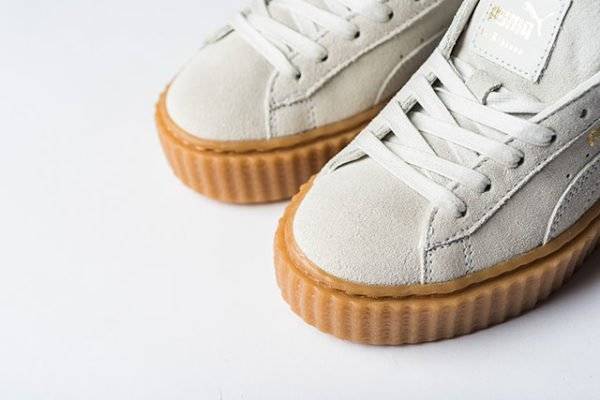
Light-colored nubuck shoes require daily cleaning
Use tools at hand to remove dirt and black streaks from the surface.
Methods for removing dirt from nubuck and velor shoes - table
| Means | How to cook | Mode of application |
| Ammonia | Dilute with water in equal proportions |
|
| Vinegar solution | 1 tbsp. l. 9% vinegar in 0.5 liters of water |
|
| Ethanol | Dilute with water in equal proportions |
|
Once every 1-2 weeks, you need to treat velor shoes with soapy water:
- dilute 1-2 tbsp. l. liquid soap in ½ liter of warm water;
- moisten a soft toothbrush in the solution and treat the surface;
- Wipe your shoes with a soft cloth dipped in cool water.
To remove greasy marks from velor or nubuck, apply a piece of stale bread to the problem area, lightly blot it (or just press for 2-3 minutes), and then comb the pile.
How to clean up your wet nubuck boots
Bad weather leads to two problems with velor shoes: the pair becomes wet and dirty. The plan of salvation involves action in both directions. Let the shoes dry first. Then use steam to "open" the pile and brush it with a soft toothbrush. You can steam over a kettle or with an iron. Just keep in mind that you cannot touch the shoes with the hot sole of the device.
12 ways to clean your white sneakers
- Toothbrush and soap are the most common way to clean yellow spots and streaks from white shoes. Get a hard or semi-hard old toothbrush and liquid hand soap. Pour liquid soap on the brush and rub the yellow stains thoroughly and vigorously. Then wash off the soap with a soft damp cloth and rinse the sneakers;
- You can use unaddressed whitening toothpaste instead of soap. Apply the paste with a brush to the surface and let sit for twenty minutes. Then rinse your shoes thoroughly in cool water;
- Combine laundry detergent, lemon juice, hydrogen peroxide, and vinegar. Apply the resulting mixture to the material with an old toothbrush and brush the surface. Then wash off the composition in clean cool water;
- Ammonia is an old proven remedy for removing dirt and stains. First, wash your sneakers by hand and dry. Then soak a cotton pad in an ammonia pad and wipe the dirty areas until the stains disappear;
- Grass stains or stubborn and stubborn stains are removed with a mixture of baking soda and lemon juice. Mix the ingredients, apply the composition to the contaminated areas and leave for twenty minutes. Then wash your sneakers with powder;
- White sneakers are often cleaned with baking soda and peroxide or vinegar. Soda is mixed with hydrogen peroxide or vinegar in a 2: 3 ratio. The result should be a fine foamy paste. Thoroughly wipe off stains and dirt with a product and rinse shoes in cool running water;
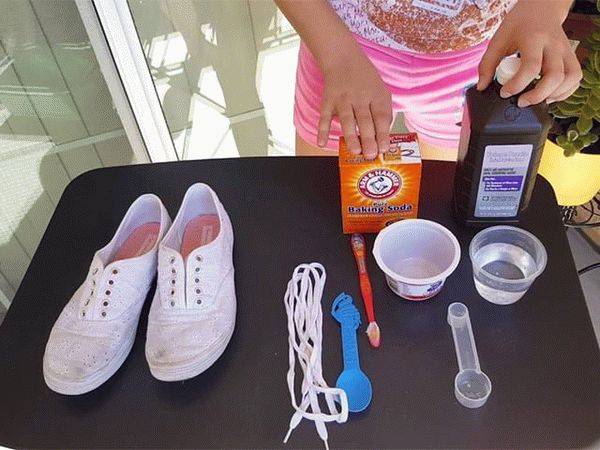
- An alternative to bleach is regular lemon. Cut the fruit in half, take one piece and wipe the surface of the shoe. Stubborn stains and dirt can be rubbed with lemon juice and left for twenty minutes. After procedures with lemon, be sure to rinse your sneakers in clean cool water;
- Vaseline can be used to clean the soles. It will remove scuffs, dirt and scratches, and will return the product whiteness and attractive appearance. Apply petroleum jelly to the surface, avoiding fabric areas, as the product may leave light spots on the material. Leave it on for 5-10 minutes and then wash off with a damp cloth;
- Scratches on the sole of the sneaker will be effectively eliminated by nail polish remover with acetone. Soak a cotton pad in the product and rub the scratch until completely removed;
- You can use a shoe eraser to remove dark streaks, scratches and scuffs. These are gentle and effective products that will gently clean your sneakers. Moreover, they do not contain any chemical components, so such erasers are absolutely safe;
- Take special powders, cleaners and stain removers for fabric shoes;
- If stains and dirt cannot be removed, use a special paint for shoes. Match the product to match the shoes and paint over the stains as indicated in the instructions.
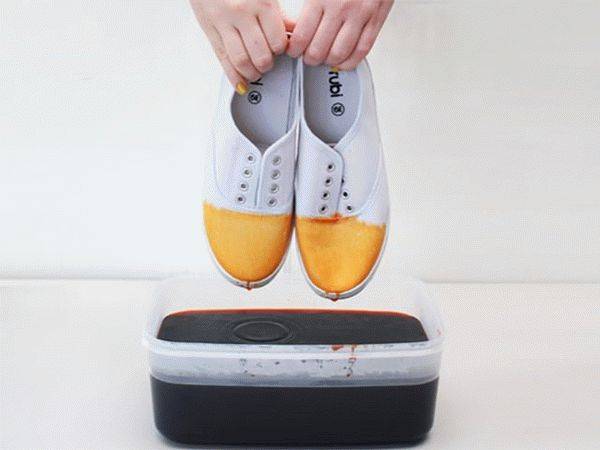
How to remove paint from a brush: 13 best tools, rules for washing at home
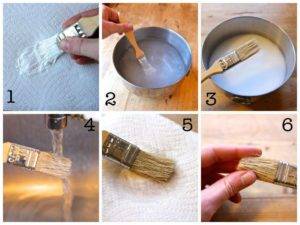
In almost any repair work, painting is indispensable. Consumables in this case are not only paints, but also brushes, which, if desired, can be used to extend the service life. So, with proper care, any instrument will retain its functional ability. In this regard, the question of how to properly clean the paint from the brush remains relevant.
Nitro paints
Nitro paints are a finishing material that is characterized by the fastest drying among other paints and varnishes. That is why they are more often applied using a spray gun, but it also happens that the masters take up a brush. In this case, the question arises of how to wash the instrument.
Nitro solvents
Nitro thinners are the simplest and most obvious way to clean your brush quickly and effectively.
These are special products that are designed to combat nitro paint residues. All that is required is to carefully study the instructions for use for the selected drug.
Acetone
Acetone is also used if you need to clean the instrument from nitro paints. In this option, you do not need to leave it in the solution for a long time. As a rule, you need to wipe the bristles with the compound, then rinse with warm water and leave to dry.
Oil
Despite the fact that oil paints dry for a long time, brushes are deformed from them at least often. So, the composition is clogged between the bristles of the instrument, and if appropriate measures are not taken immediately, it can be thrown out.
Turpentine
In this option, you need to start cleaning the brush immediately after the end of the work. The tool is wiped in order to remove paint residues, and then washed with turpentine.
RS-1
This product is aggressive and requires careful handling. Wipe the instrument with a thinner, then rinse with water and leave to dry
White Spirit
The best option for eliminating oil paint residues is the process of soaking the tool in white spirit. Then it is washed under running water, wiped, trying to give the bristles their original appearance, and left to dry.
Alkali solution
If the oil paints have already dried, an alkali solution is used, in particular, we are talking about caustic potassium.
If the brush is made of synthetic materials, an alkaline cleaning solution will not work.
Isopropyl alcohol
Isopropyl alcohol will deal with dry paint residues. After cleaning, the instrument is rinsed and allowed to dry in an upright position.
Vinegar
The tool is soaked in vinegar for 60 minutes, after which the condition of the bristles is checked. If the bristles are not yet soft enough, repeat the procedure. Next, the brush is washed in clean water and left in an upright position until completely dry.
Dishwashing liquid
Try to squeeze the maximum paint out of the brush with a paper towel or cloth. Next, a small amount of dishwashing liquid is poured onto the hand, after which the bristles are washed under warm water.
Water-based
Water-based paint is easier to clean. It is advisable to wash the brush immediately after use under running water. If the paint has already dried on the instrument, it is easy to remove it with improvised means: detergent for washing kitchen utensils, soap.
Acrylic
To avoid problems with cleaning brushes, it is worth using water-based paint liquids: acrylic, watercolor, latex. Next, we will consider several proven ways to clean the tool from the remains of the coloring material.
Degreaser
The use of degreasing agents is relevant in a situation if the tool has been in the paint for a day and a film has formed on it.
The algorithm for using the drug is indicated on each individual product by the manufacturer.
Special cleaners
Most often, brushes are cleaned with a Universal Cleaner, which is designed to degrease coatings.
The product contains alcohol and gasoline.
Brush care rules
To prolong the life of your brush, you should adhere to the following rules:
- The brush should dry exclusively in a horizontal position.
- Do not leave the instrument in water with the bristles down.
- It is recommended to wear an elastic band on the bristles so that the tool dries in the correct position.
- If, after cleaning, there are loose bristles on the brush, they should be removed with tweezers.
- If you are using oil paints on a daily basis and cleaning your brushes becomes a chore, you can try wrapping your tools in a zip-lock bag. The fact is that if you leave the brushes constantly in a solvent, their service life will be significantly reduced.
How and how to wash?
Before you start washing your white sneakers, there are some important points to keep in mind. So, machine wash is contraindicated in the following cases:
- fabric sneakers are damaged on the upper or on the sole,
- products are inexpensive, not of very high quality,
- leather sneakers,
- they have small fragile parts (reflectors, for example),
- the washing machine does not have (or does not work) the "Sport", "Delicate" mode or the option to turn off the spinning and drying: washing in the usual mode for such shoes is strictly prohibited.
In addition, depending on the composition of the textiles, yellow spots and streaks may appear after washing with ordinary detergent, especially when using a fabric softener. Therefore, it is best to use powdered laundry soap or oxygen bleach to wash your athletic shoes.

What is detrimental to artificial skin
The natural material from which shoes, clothes, and upholstery are made for furniture is durable, elastic, but expensive, and animals are exterminated for production. The basis for eco-leather is a cotton fabric on which polyurethane is applied.
High humidity
Eco-leather does not let water inside. The machine is not suitable for washing products made of two-layer material, dirt on them is not washed off with water. High humidity will negatively affect the fabric.
Heat
Eco-leather transmits heat well, products from it do not fade in the sun, but they overheat greatly, it is not recommended to wash in hot soapy water.
Steam generator cleaning
Synthetic fabric with a PVC coating is not inferior in technical characteristics to leather, looks like a natural material, but with improper care it loses its attractiveness. Do not clean products from it with a steam generator.

Abrasives
If you wipe the eco-leather with a stiff brush or pumice stone, scratches, microcracks, small cuts appear on the surface. The fabric is damaged when cleaning with abrasive materials, does not tolerate chlorine.
Daily care rules
Furniture upholstery, clothes made of light eco-leather retain their attractiveness, do not wear out for a long time, if the products are regularly and properly looked after:
- Remove dust with a damp cloth.
- Wipe off dirt with coarse calico, microfiber, flannel napkins.
- Apply a water-repellent compound every 6 months.
- Polish to restore shine with creams designed for natural leather.
When cleaning stains, do not apply pressure to the surface of the car cover or upholstery. A sofa or chair made of two-layer material should be installed away from batteries, make sure that the direct rays of the sun do not fall on things.
How to wipe off a stain of paint on your face?
There are several known methods for solving this problem. It should be borne in mind that the skin of the face is very delicate. Moreover, she is always in sight.
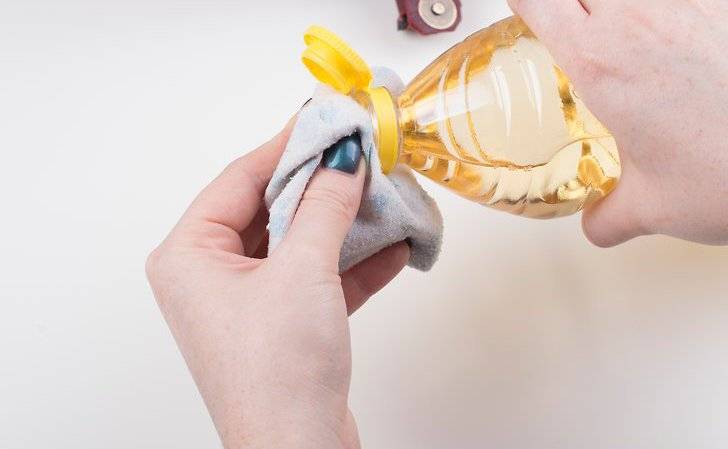
How to wash hair dye from your face? If all the precautions have not worked, you need to use the following gentle methods:
If the stain is fresh, you can use baby soap. Apply to a sponge and gently clean the contaminated area. The procedure is usually repeated 2-3 times. You can remove paint stains with lotion containing alcohol.It is applied to a cotton pad and the contaminated area of the skin is treated. After removing the stain, dryness may appear. It is recommended to apply a moisturizer to the skin. In order to get rid of stains, you can prepare a specific mask. You can apply a little olive, linseed or vegetable oil to the stain. Leave on for 20 minutes and rinse with warm water. When removing a stain with baking soda, an unpleasant sensation sometimes appears on the skin. The product is diluted with water in equal proportions.
Scrub is applied to the contaminated area and leave for 3-5 minutes, then gently rinse
How to clean hair dye from hands and other areas of the body? When removing stains from the face, especially with baking soda, precautions should be taken. Avoid eye contact
And also you do not need to intensively rub the contaminated area, otherwise it may turn red.
How to remove tar from a car
We take a dry rag and moisten it in gasoline, then we carry it through tar stains or bitumen. We wait about 3 minutes and wash off the stains from the body with the same rag. The paintwork of modern cars is quite resistant, so do not be afraid to use gasoline. The main thing is that before and during such processing, the coating is not damaged. Therefore, do not allow sand or other abrasive material to get on the rag.
If your car is not new or you are still afraid to use gasoline, then modern chemical manufacturers offer you a wide range of special products, taking into account all the features of car coatings. Sales consultants of any industrial chemistry store will promptly select the necessary tool for you.
What do we need
The task was set: to clean nubuck weekend shoes at home. You will need: a can of foam or spray, a brush, an eraser and a little savvy. The funds are applied alternately, depending on the degree of pollution and the expected effect. It is also allowed to use improvised methods, which will be discussed separately.
Aerosol impregnation
The initial stage involves the processing of nubuck with aerosol impregnation. It is sprayed from a cylinder, dries quickly, leaving a protective hydrophobic layer on the surface. Of the well-known and eminent, Salamander is used, there are also simpler options - Shtrikh, Centro, Erdal.
Cleanser (foam)
A relatively easy way to restore the exterior of nubuck boots. The consistency is similar to shaving foam. It is applied to the surface to be treated, then the active reagent binds the dirt particles, "knocking out" them from the pile. It remains to wait for the foam to dry, and then clean the nubuck with a special stiff brush.
Spray paint for nubuck shoes
Among the manufacturers - well-known Salamander, Centro, Erdal
It is important not to confuse the color of the shoes with the color of the aerosol, so as not to hopelessly ruin the shoes. There are no universal (colorless) dyes, specific instructions, recommendations are indicated on the bottle with the composition
Eraser
A special elastic band will help remove dirt from shoes, restore the pile. They work with an eraser on a dry surface, systematically wiping off foreign inclusions.
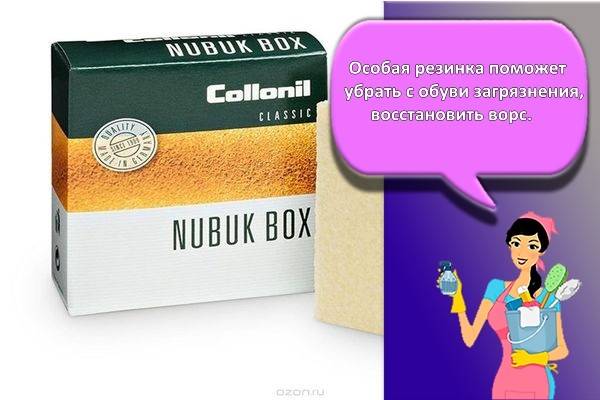
Sometimes this helps to avoid the use of radical cleaning products when the shoes are not too dirty or worn out.
Special brush
Let's make a reservation right away: we are not talking about toothbrushes, old clothes or something else like that. You will need special tools - with rubber, metal bristles. By the nature of the impact, the brush resembles an abrasive, which initially creates a nubuck structure: it also restores the pile, removes stubborn dirt.
Deodorant for shoes
A special tool allows you to get rid of unpleasant odors, clean the inner surface of the shoe. The appearance of a specific amber is associated with various reasons: the habit of wearing boots, shoes on bare feet, excessive sweating, and so on. The deodorant removes odors, restores shoes to their original state.
How to clean makeup brushes
1.Baby shampoo

For many years I have been washing my brushes with baby shampoo. During all this time, they have not lost their shape, but, on the contrary, have retained it.
How to shampoo makeup brushes
First, squeeze a drop of baby shampoo onto a cotton swab.
Carefully dip the brush into the detergent.
“Twirl-twirl” in the palm of your hand until the nap of the brush is cleaned.
We rinse with water.
Bottom line: This method is acceptable for brushes that only you use. If you work as a makeup artist, then you definitely need to disinfect your brushes! And the next option is just for you.
2. Special means for cleaning brushes (Makeup Brush Cleaners)
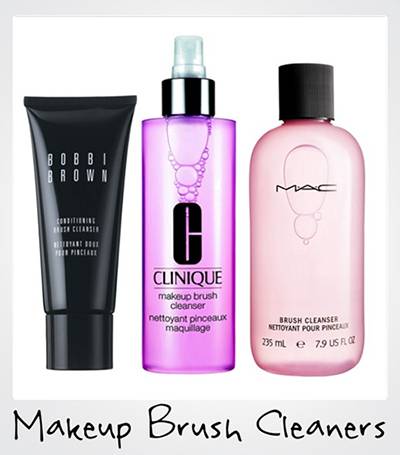
Similar fluids can be found in every brand. This applies not only to professional but also luxury brands, for example:
- Bobbi Brown Conditioning Brush
- Clinique Makeup Brush Cleanser
- Estee Lauder Makeup Brush Cleaner
- Mac Cosmetics Makeup Brush Cleanser - I use it to wash my "working" brushes (read the review here).
How to wash your brushes with the special brush cleaner
I talked about this in detail in the article "How to wash brushes using a special tool"
Bottom line: the difference between these products is that they contain alcohol, which is necessary for disinfecting the brushes!
If you are afraid that alcohol will badly affect the pile, then this is not the case. A certain amount of alcohol has long been calculated in such products and believe me, they are not intended to destroy brushes, but only to disinfect them.
3. Tea tree oil
It has been noticed that tea tree oil has antibacterial properties, though not as strong as previous remedies.
How to clean brushes with tea tree oil
- Add 3-4 drops of tea tree oil to a container of warm water.
- Lower the brush and rinse.
- You can add one teaspoon of baby shampoo to make sure your brushes are clean.
Bottom line: I have never tried this cleaning method, but I heard about it as the most positive way.
4. Napkins or makeup remover as a way to cleanse brushes (Makeup Remover Wipes)

This method is convenient when traveling, when there is no oil, no special product, no baby shampoo at hand! I'm sure no girl will forget to take makeup remover on a trip. This is exactly what will help out your brushes.
How to clean brushes with makeup remover wipes
- Dampen a cotton swab with makeup remover
- Brush over it a couple of times until it is clean.
- The same can be done with napkins - with the help of circular movements of the brush until completely cleansed.
5. Laundry soap
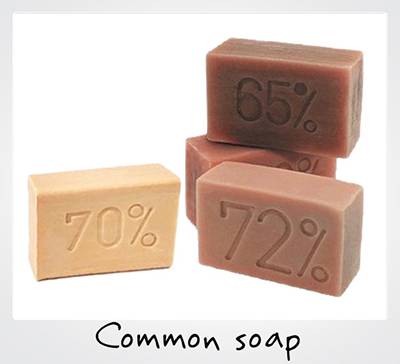
The only tool that completely removes creamy textures from brushes! This includes watercolors, waterproof cream eyeshadow and foundation.
How to clean your brushes with laundry soap
- Brush the soap a couple of times
- Clean with circular motions in the palm of your hand.
- Rinse with water.
Bottom line: I am completely calm about the condition of the brushes after this method of cleaning, since when working with creamy textures you are dealing only with synthetic, not natural, bristles. Only with this soap do I manage to wash brushes after creative make-up.
How to dry makeup brushes
- After you have washed the brushes, in no case put them directly into the glass, otherwise water will get into the mounting place and dilute the glue! Result: a handle that fell off.
- Place them on a pre-laid out napkin on the table. I use kitchen paper towels.
- Wash your brushes at least once a week. If you have rashes and other skin problems, then try to wash them more often, at least every other day.
Gossip
- They say that brushes that have lost their shape can be restored to life by holding them in water at 90 ° C. about 3 minutes.
- They also say that it is possible to disinfect brushes with chlorhexidine, as one of the cheapest options.
I have not tested these options, because I do not want to risk brushes, which I love very much and treat them thriftily.
Conclusion: it depends only on you how long your makeup brushes will last. Choose a cleanser depending on the challenge you face. Dry properly and keep them clean.
How to prepare your sneakers for cleaning
First of all, you need to clean the white soles of your sneakers from dirt and sand. To do this, take a soft cloth and soak it in warm soapy water. To prepare the solution, add liquid soap or shabby bar soap to warm water and stir until foam appears. You can use shoe polish instead of soap.
To clean the white sole, soak a cloth in the solution and wipe the surface. Remove dirt and sand between the embossed elements with a soft brush or an old toothbrush. Then wipe the soleplate with a damp, clean cloth and dry with a dry cloth.
If yellow spots and streaks are present on the white soles, use chlorinated bleach. Dilute the remedy in cool water in 1 to 10 ratio and lower the sole so that the fabric does not get into the bleach. Soak the product in the solution for half an hour and then start cleaning.
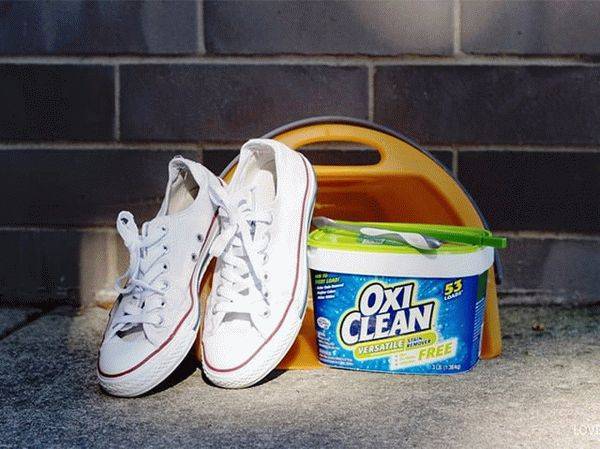
You can also use whiteness to clean the soles. It perfectly whitens, removes dirt and scratches. However, it is aggressive and can damage the material.
Therefore, whiteness cannot be used for fabric, it can only be used for rubber soles. Dissolve a small amount in water and use a stiff old toothbrush. Dip the brush into the solution and scrub off the dirt.
After you've cleaned the outsole, take out the insoles and laces. These items are washed and dried separately. Then you need to decide how to clean your shoes.
The most affordable, economical and gentle method is to wash or clean white fabric sneakers by hand. This method will preserve the material of the products. However, you can wash sneakers in a washing machine, but strictly following the rules and recommendations.


